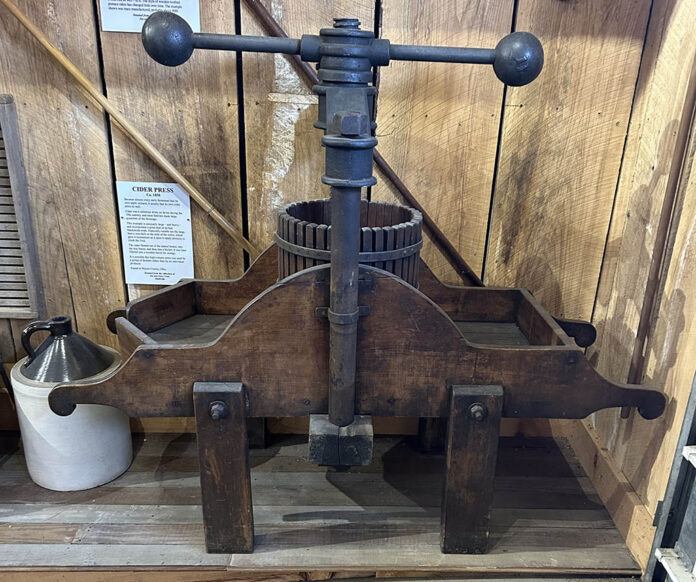
Author’s Note: The description of apple butter making in this and coming chapters is a generalization of how the process was carried out. Different families had different traditions regarding how to accomplish this task, and each was pretty sure their particular way was the only correct way. What is presented here is a general description of how the job got done.
Jerome Monroe Smucker, of Orrville, Ohio, founder of the J.M. Smucker Company, may have whetted the nation’s appetite for apple butter, but it was a product that had strong traditions dating back numerous generations.
Apple butter seems unquestionably and forever linked with the German communities of the southeast Pennsylvania region, and it may well be that it was the Germans who introduced this food in the early years of America. As settlers moved out of that geographic area and over the Appalachian and Alleghany Mountains into the Ohio country, they brought the tradition along with them. As soon as they were able to develop apple orchards, the Pennsylvania German settlers began making apple butter in a tasty rite of autumn.
Apple butter making was typically reserved for that special moment when the fieldwork had just come to an end for the year and the farmers needed to catch their breath before plunging headlong into a formidable array of winter chores. Of course, the apple harvest brought its own inherent load of work, primarily for the women of the family. But that’s another tale for another chapter coming up shortly.
The making of apple butter — although generally regarded as light work in the overall scheme of things — was in fact a very labor-intensive process involving multiple days. In an attempt to make that work more fun, the settlers did what they always did in that kind of situation, which was to make it into a party of sorts, a frolic if you will (let’s not call it a bee this time). The host of the apple butter party provided all necessary equipment for the operation, along with food, drink and maybe some additional entertainment for the neighbors.
The kettle

The day prior to the actual cooking was spent readying both the equipment and apples. First, the large copper apple butter kettle was gotten out of the barn, washed and its interior scrubbed to a gleaming shine. The majority of early apple butter kettles held 40 gallons and were crafted by hand in Lancaster, Pennsylvania. The seams where the side pieces joined were typically dovetailed together, the joinery being not unlike that found in fine wooden cabinetry.
After the circular sides were formed, the one-piece bottom was dovetailed to the sides. The handle was an inch-thick wrought iron rod bent into a semi-circle. Its ends were inserted through wrought iron cleats, which were riveted through the sides, just underneath the rolled rim. The rim disguised a heavy circular iron rod which allowed the kettle to maintain its shape. In the fancier examples, the cleats were wrought by the blacksmith to resemble a tulip, a folk motif that appears integral in many early Pennsylvania German products. Some kettles additionally had copper lids in a shallow pyramidal shape.
Also located in the barn where they had languished for at least a year were the wrought iron kettle stand — which consisted of a ring in which the kettle sat while suspended about a foot-and-a-half off the ground by three legs — and the wooden apple butter paddles. As the name implies, the paddles were used in stirring the apple butter, and from the number of these that have survived over the decades, it seems that every family must have owned a bunch of them.
Paddles
Apple butter paddles usually consisted of two pieces, a handle usually measuring between 6 feet and 8 feet in length, designed to keep the user away from the fire, and the paddle itself, which was attached to the end of the handle at a 90-degree angle. The paddle head was typically a little longer than the kettle was deep so that it could agitate the entire contents of the kettle and prevent them from burning during the lengthy process. The paddle head was often attached to the handle with a wooden pin or wedge, and sometimes braces were added at a 45-degree angle between the handle and sides of the paddle.
Like so many other household articles crafted in early America, the heads of the apple butter paddles often became the canvas of the folk artist. While the point was to create a series of holes through which the butter could flow as it was stirred, those who drilled the holes sometimes decided to create motifs such as tulips and other kinds of flowers, human faces, hearts, pinwheels or hex signs, although such folk art pieces are rare today. These paddles took considerable abuse and it seems the more elaborately they were drilled or carved, the less likely they were to survive.

Also brought out was a large sheet of metal — often corrugated roofing — which was used to block any breeze that was blowing across the fire, thus keeping a steady heat under the kettle. Needed as well were a sturdy table on which to set the numerous pottery crocks into which the apple butter would be ladled, a clean cloth to dry the freshly washed crockery and plain butchering paper to go over the filled crocks, tied on with string.
Next, the apples from the fall harvest were scrutinized for worms, bruises or rotten spots and the good ones were selected to include in the apple butter. Just as in a good cider, which encompasses multiple kinds of apples, a good apple butter blended the flavors of both sweet and tart apples, along with special spices that were an important element of such family recipes.












